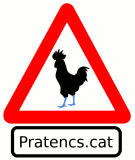"The Age of the Dictionary" o "The definition of a hopeless task" és el setè capítol de The history of English in ten minutes, una sèrie de deu vídeos molt breus i lleugerament didàctics sobre l'anglès de l'Open University. El capítol se centra en la tasca dels primers grans lexicògrafs anglesos, els superhomes autors del Dictionary of the English Language o l'Oxford English Dictionary.
A banda de descobrir nous usos domèstics dels diccionaris, un hi troba mots fantàstics com ara pickle herring, jobbernowl, fopdoodle o snuffbumble, paraules absolutament prescindibles (i per això fascinants) per a qualsevol dels 300 milions de parlants de l'anglesa llengua, però que podrien haver format part perfectament del bagatge imprecatori d'Arxibald Haddock.
Aquesta és la transcripció del text:

Fopdoodle ja s'havia reivindicat en una obra del 2007
A banda de descobrir nous usos domèstics dels diccionaris, un hi troba mots fantàstics com ara pickle herring, jobbernowl, fopdoodle o snuffbumble, paraules absolutament prescindibles (i per això fascinants) per a qualsevol dels 300 milions de parlants de l'anglesa llengua, però que podrien haver format part perfectament del bagatge imprecatori d'Arxibald Haddock.
Aquesta és la transcripció del text:
"With English expanding in all directions, along came a new breed of men called lexicographers, who wanted to put an end to this anarchy – a word they defined as ‘what happens when people spell words slightly differently from each other’.
One of the greatest was Doctor Johnson, whose ‘Dictionary of the English Language’ which took him 9 years to write.
It was 18 inches tall and 20 inches wide – and contained 42,773 entries – meaning that even if you couldn’t read, it was still pretty useful if you wanted to reach a high shelf.
For the first time, when people were calling you ‘a pickle herring’ (a jack-pudding; a merryandrew; a zany; a buffoon), a ‘jobbernowl’ (loggerhead; blockhead) or a ‘fopdoodle’ (a fool; an insignificant wretch) – you could understand exactly what they meant – and you’d have the consolation of knowing they all used the standard spelling.
Try as he might to stop them, words kept being invented and in 1857 a new book was started which would become the Oxford English Dictionary. It took another 70 years to be finished after the first editor resigned to be an Archbishop, the second died of TB and the third was so boring that half his volunteers quit and one of the ended up in an Asylum.
It eventually appeared in 1928 and has continued to be revised ever since – proving the whole idea that you can stop people making up words is complete snuffbumble."

Fopdoodle ja s'havia reivindicat en una obra del 2007
Via "Història de l'anglès en deu minuts" a Bloc de Lletres















Mil milions de jobbernowls! M'encanta aquest Tintín tan pop que qui sap on mena.
ResponEliminaT'ho podries currar (és en el diccionari aquesta paraula?) i fer dues coses:
ResponElimina- Subtitular el present vídeo
- Fer-ne un dels diccionaris catalans
Així doncs, ja saps, tira endavant noves possibilitats d'aquest magnífic bloc!
Allau: És Tintín llegint The Daily Avalanche en versió paper. A la seva època no hi havia encara blocs.
ResponEliminaPer si algú ho desconeix és el quadre Tintin reading que pintà a l'oli Roy Lichtenstein l'any 1993. I surt a la portada de la novel·la Tintín al nou món de Frederic Tuten.
Pisco: Aquest bloc en té prou amb compartir les fantàstiques troballes lexicogràfiques que fan els altres. Els de Blocs de Lletres, per exemple.
ResponEliminaEl que em sap greu és que no he sabut trobar l'autor dels dibuixets.
Jo!, com és de bo aquest apunt!
ResponEliminaGenial la peli del que és un diccionari... (per cert que he de tornar a reclamar la moneda!!!!)
La moneda on surt el de la coberta, és cert!
ResponEliminaTots els capítols tenen la seva gràcia.